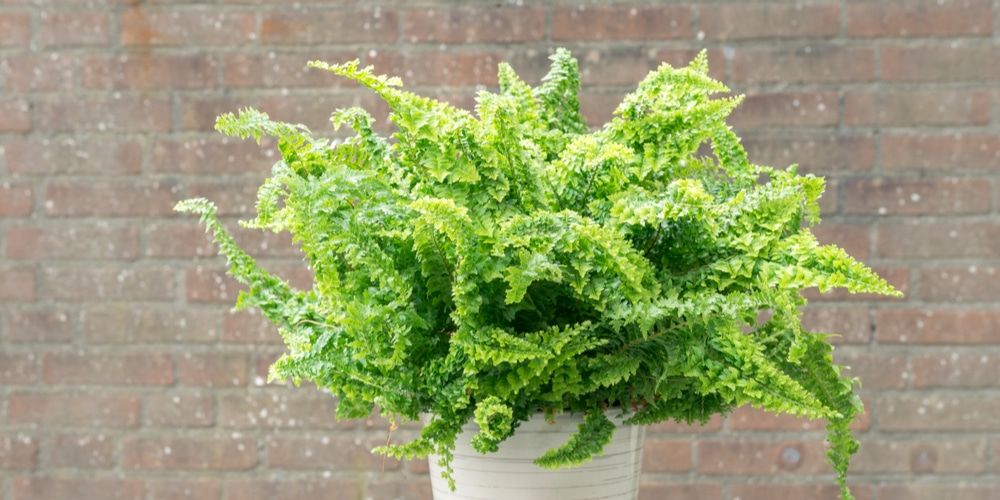If you’ve been searching for an interesting, low-maintenance houseplant, you may have come across the macho fern. You probably already know that it is a popular choice for indoor gardens, thanks to its easy care requirements and striking appearance. But what else do you need to know about macho ferns?
Quick summary
Below is a quick preview of the main facts about the macho fern.
| Botanical Name | Nephrolepis biserrata |
| Common Name | Macho fern, giant sword fern, broad sword fern |
| Plant Type | Perennial |
| Flower Color | Doesn’t produce flowers |
| Size When Mature | 36-48 inches tall, 72 inches wide |
| Bloom Time | N/A |
| Sun Requirements | Partial sun, shade |
| USDA Hardiness Zones | 9-10 |
| Soil PH Range | Slightly acidic, 6.0-6.5 |
| Soil Type | Moist, well-draining |
| Water Needs | Medium |
| Native Area | North America |
What you need to know about the Macho fern
Nephrolepis biserrata, better known as the Macho fern, is a perennial evergreen fern that is native to tropical regions in North America.
Also known as the “giant sword fern” or “broad sword fern” due to its huge fronds that can reach lengths of up to 4ft, the Macho fern is an incredibly popular houseplant.
And with the width of the entire plant being close to 6ft, the Macho fern can easily become the focal point of any room.
Not only is it impressive in size, but it’s also relatively easy to care for making it a great plant for those who are new to gardening or keeping houseplants.
As if that is not enough, it is a widely adaptable plant that can be grown both indoors and outdoors in a variety of conditions. It, however, prefers being located in a warm, shady region that has consistent moisture.
With proper care, the Macho fern can even be used as a ground cover or as a hanging plant. One of the most important facts about the macho fern is that it does not tolerate under-watering.
Macho Fern Care
The Macho fern is a tough plant that can tolerate a wide range of growing conditions. However, there are a few things to keep in mind if you want your plant to thrive.
Light:
The Macho fern does best in bright, indirect light when planted indoors, but it can also tolerate low light conditions. If you are growing your plant outdoors, it is best to choose a spot that is shaded or partially shaded.
If your macho fern has to receive direct sunlight, it should be for a preferred 4-6 hours per day. Just make sure that you protect it from the harsh afternoon sun since that can scorch the leaves.
For indoor plants that are on hangers or close to smaller windows, it’s important to rotate them once a week or once every two weeks. That way, each side of the plant gets an equal amount of light, hence uniform growth.
Water:
One of the most important things to remember when caring for your macho fern is to never let the soil dry out completely. That’s in consideration that this plant does not tolerate drought.
With moderate watering needs, these plants like their soil moist at all times, but not soggy. When growing your macho fern indoors, you will want to water it one or two times a week depending on the temperature.
Soil:
When it comes to soil, the macho fern prefers rich, well-drained soil that is high in organic matter. If using potting soil, make sure it is light, airy, and slightly acidic.
It’s especially critical to avoid heavy soils that can compact around your plant’s roots, considering that macho ferns are epiphytic.
Temperature requirements:
Gian sword ferns thrive best in USDA zones 9-10, which means they prefer warm temperatures with ranges of 50-80 degrees Fahrenheit. It should also be an area with a humid environment, so frequent misting is beneficial in hot and dry conditions.
If you live in an area with cold winters, it’s best to grow your macho fern in a grow pot or container. That way, even if you want your plant to spend the warm months outdoors, it will be easy to overwinter them indoors when the temperatures start to drop.
Fertilizing:
Fertilize your young macho ferns once every six weeks during the spring and summer with an all-purpose, balanced fertilizer. Conversely, adult plants only need to be fed once every six months using the same all-purpose fertilizer.
Propagating macho ferns
One of the great things about macho ferns is that they’re very easy to propagate. If you want to increase your plant collection or share your ferns with friends and family, all you need to do is use the division method.
Start by finding a healthy, mature plant and dig it up, exposing the roots and rhizomes. Selective a couple of healthy rhizomes and separate them from the mother plant. You may need to use a sharp knife for this.
Plant the separated clumps in different locations or containers that have well-draining potting mix and water them generously. Place the pot in a warm, humid area with indirect light and keep an eye on the soil, watering as needed to keep it moist.
You can even use clear plastic bags to cover the repotted clumps, mimicking a greenhouse environment. That way, they will have better growth conditions that will allow them to establish faster.
Final word
Macho ferns are easy to take care of as long as you provide them with the right growing conditions. With a little bit of care and attention, your plant will thrive and provide you with beautiful, lush foliage that is perfect for adding a tropical touch to any space.


